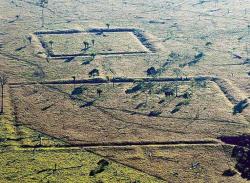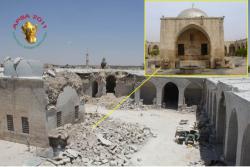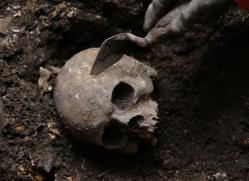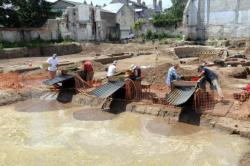INSTITUT SUPERIEUR D'ANTHROPOLOGIE
INSTITUTE OF ANTHROPOLOGY
ONLINE COURSES / COURS A DISTANCE
FALL TERM : OCTOBER 2015
REGISTER NOW
BRESIL –  Amazonie - Des archéologues ont trouvé des tranchées ou des fosses datant de plusieurs centaines d'années sous les arbres de la forêt amazonienne. Il pourrait s'agir d'anciennes routes. Plus de 200 structures circulaires ou rectangulaires ont été retrouvées au cœur de la forêt amazonienne après que celle-ci a subi une importante déforestation pour les besoins en alimentation du bétail. Aidés par Google Earth, les archéologues ont découvert de nombreuses tranchées et fosses, d'une profondeur entre 1 et 4 mètres et d'une largeur de 11 à 12 mètres. Ils ont également déterré des poteries, des pierres sculptées et d'autres éléments qui pointent vers des signes d'habitations humaines. Bien que tous les sites concernés ne contenaient pas d'artefacts, les chercheurs suggèrent que certains auraient eu des fonctions protocolaires tandis que d'autres pourraient avoir eu des fins défensives. Les scientifiques ont estimé l'âge de ces sites entre 750 ans et 1800 ans. Les formes géométriques indiquent une probable signification symbolique, peut-être utilisée pour des cérémonies. Les chercheurs estiment que certains villages auraient abrité jusqu'à 5000 habitants, un chiffre important pour l'époque et surtout pour la région puisque la population devait se contenter des ressources de la forêt, l'Océan étant très éloigné. Il est possible que d'autres structures soient présentes dans des zones où les arbres n'ont pas été déracinés. Peut-être en apprendrons-nous davantage d'ici quelques années, notamment sur la raison de la disparition de ce peuple d'Amazonie. Pour l'instant, pour les scientifiques, cette civilisation aurait été victime de maladies apportées par les colons européens il y a 500 ans. L'Amazonie est devenue un gigantesque chantier. La découverte des richesses contenues dans le sous-sol a provoqué la ruée des aventuriers de toutes nationalités. Son sous-sol contient de fabuleuses richesses notamment des milliers de tonnes de minerais (fer, cuivre, manganèse, bauxite, or…).
Amazonie - Des archéologues ont trouvé des tranchées ou des fosses datant de plusieurs centaines d'années sous les arbres de la forêt amazonienne. Il pourrait s'agir d'anciennes routes. Plus de 200 structures circulaires ou rectangulaires ont été retrouvées au cœur de la forêt amazonienne après que celle-ci a subi une importante déforestation pour les besoins en alimentation du bétail. Aidés par Google Earth, les archéologues ont découvert de nombreuses tranchées et fosses, d'une profondeur entre 1 et 4 mètres et d'une largeur de 11 à 12 mètres. Ils ont également déterré des poteries, des pierres sculptées et d'autres éléments qui pointent vers des signes d'habitations humaines. Bien que tous les sites concernés ne contenaient pas d'artefacts, les chercheurs suggèrent que certains auraient eu des fonctions protocolaires tandis que d'autres pourraient avoir eu des fins défensives. Les scientifiques ont estimé l'âge de ces sites entre 750 ans et 1800 ans. Les formes géométriques indiquent une probable signification symbolique, peut-être utilisée pour des cérémonies. Les chercheurs estiment que certains villages auraient abrité jusqu'à 5000 habitants, un chiffre important pour l'époque et surtout pour la région puisque la population devait se contenter des ressources de la forêt, l'Océan étant très éloigné. Il est possible que d'autres structures soient présentes dans des zones où les arbres n'ont pas été déracinés. Peut-être en apprendrons-nous davantage d'ici quelques années, notamment sur la raison de la disparition de ce peuple d'Amazonie. Pour l'instant, pour les scientifiques, cette civilisation aurait été victime de maladies apportées par les colons européens il y a 500 ans. L'Amazonie est devenue un gigantesque chantier. La découverte des richesses contenues dans le sous-sol a provoqué la ruée des aventuriers de toutes nationalités. Son sous-sol contient de fabuleuses richesses notamment des milliers de tonnes de minerais (fer, cuivre, manganèse, bauxite, or…).
http://www.lefigaro.fr/culture/2015/06/18/03004-20150618ARTFIG00263-une-civilisation-inconnue-revelee-en-amazonie.php#xtor=AL-201
SYRIE –  Maaret al-Numan - The museum building and several mosaic panels were damaged by shrapnel in the northern rebel-held town of Maaret al-Numan.The Association for the Protection of Syrian Archaeology said the museum "suffered serious damage caused by two explosive-packed barrels dropped by Syrian army helicopters". The non-governmental organisation published pictures of the museum, located in an ancient Ottoman caravanserai, showing entire walls once covered with mosaics collapsed into rubble. Several mosaic panels were badly broken in the eastern portico of the museum and two were knocked off their display by the sheer force of the bomb blast. The museum is home to an outstanding collection of Roman and Byzantine mosaics from the 3rd to 6th centuries A.D. The fragile mosaics in the museum are at constant risk from both random bombing and deliberate damage and looting. The museum is famed for its mosaics from the Dead Cities, the Great Mosque of Maarrat al-Numan, a madrassa built by Abu al-Farawis from 1199 and remains of the medieval citadel.
Maaret al-Numan - The museum building and several mosaic panels were damaged by shrapnel in the northern rebel-held town of Maaret al-Numan.The Association for the Protection of Syrian Archaeology said the museum "suffered serious damage caused by two explosive-packed barrels dropped by Syrian army helicopters". The non-governmental organisation published pictures of the museum, located in an ancient Ottoman caravanserai, showing entire walls once covered with mosaics collapsed into rubble. Several mosaic panels were badly broken in the eastern portico of the museum and two were knocked off their display by the sheer force of the bomb blast. The museum is home to an outstanding collection of Roman and Byzantine mosaics from the 3rd to 6th centuries A.D. The fragile mosaics in the museum are at constant risk from both random bombing and deliberate damage and looting. The museum is famed for its mosaics from the Dead Cities, the Great Mosque of Maarrat al-Numan, a madrassa built by Abu al-Farawis from 1199 and remains of the medieval citadel.
http://www.ibtimes.co.uk/maarra-mosaic-museum-suffers-massive-destruction-barrel-bomb-attack-by-syrian-army-1507171
INDE – Budhigarh - The excavation conducted on the left bank of river Rahul in Tel River Valley in Budhigarh of Kalahandi district between February and May has unearthed antiquities belonging to early history.The preliminary excavation found several artifacts like pottery and teracotta items, semi-precious stone beads, pendants, iron objects, charcoal, remains of fauna and a brick wall having 28 courses and the floor made of the same kind of bricks. “The bricks of 45x30x6 cm dimension and having cross mark found from the site belong to Saka-Murunda period of second century AD which has been identified at different early historic sites of India including Kharligarh of Tel Valley,” Dr Mishra said. The excavation has traced the cultural relics at least from the Gupta to the pre-Gupta period. Further excavation will expose the whole brick complex and shed ample light on ancient Indian architecture, he said. “Budhigarh is a rich archaeological site and was an early historic urban centre in Tel River Valley as established by earlier findings which revealed terracotta works of human beings and animals, ornaments, potteries like knobbed ware, roulette ware and black polish ware besides black and red ware; red, black and grey slipped ware, punch marked silver coin and a gold coin at the surface of the site,” Mishra said. Earlier, four Jasper seals-cum-pendants having bilingual script Kharosti-Brahmi were also found by epigraphists. During the pre-excavation survey, many semi-precious stone beads, bead moulds, clay beads, copper objects, stone bowl, saddle quern, celt and ring stones have been retrieved from the site. It is believed to be a thriving industrial and commercial hub located on the salt route leading from Madhyabharat to Kalinga via Atavi-Kantara (Mahakantara), he said.
http://www.newindianexpress.com/states/odisha/Early-History-Artifacts-Unearthed-at-Budhigarh/2015/06/20/article2876642.ece?
BELGIQUE –  Wielsbeke - A Wielsbeke, en Flandre-Occidentale, des archéologues ont découvert un cimetière couvrant une période allant de l'âge de fer à la période romaine. Septante-trois tombes anciennes ont été découvertes. Les archéologues ont également trouvé sur place des pots, des petites bouteilles, des urnes ainsi que d'autres objets liés au culte des morts. Selon les premières expertises, les vestiges découverts couvrent une période allant de -1.500 à 250 apr. J.-C., soit une période allant de l'âge de fer à la période romaine. Les découvertes ont été faites alors que des travaux étaient en cours pour la construction d'un nouveau terrain industriel dans la commune. Trois tumuli, des monticules de terres et de pierres installés autrefois au-dessus de certaines sépultures, ont également été relevés. Le premier s'étendait sur une surface de 17 à 35 mètres tandis que les deux autres avaient un diamètre de 18 mètres sur 35. "Nous ne nous attendions pas à trouver cela, mais vu la proximité de la Lys, c'était un endroit prometteur" a déclaré l'archéologue Sam de Decker de l'agence Onroerend Erfgoed. Les chercheurs parlent de la plus importante découverte archéologique depuis des années en Flandre.
Wielsbeke - A Wielsbeke, en Flandre-Occidentale, des archéologues ont découvert un cimetière couvrant une période allant de l'âge de fer à la période romaine. Septante-trois tombes anciennes ont été découvertes. Les archéologues ont également trouvé sur place des pots, des petites bouteilles, des urnes ainsi que d'autres objets liés au culte des morts. Selon les premières expertises, les vestiges découverts couvrent une période allant de -1.500 à 250 apr. J.-C., soit une période allant de l'âge de fer à la période romaine. Les découvertes ont été faites alors que des travaux étaient en cours pour la construction d'un nouveau terrain industriel dans la commune. Trois tumuli, des monticules de terres et de pierres installés autrefois au-dessus de certaines sépultures, ont également été relevés. Le premier s'étendait sur une surface de 17 à 35 mètres tandis que les deux autres avaient un diamètre de 18 mètres sur 35. "Nous ne nous attendions pas à trouver cela, mais vu la proximité de la Lys, c'était un endroit prometteur" a déclaré l'archéologue Sam de Decker de l'agence Onroerend Erfgoed. Les chercheurs parlent de la plus importante découverte archéologique depuis des années en Flandre.
http://www.levif.be/actualite/sciences/importante-decouverte-archeologique-en-flandre/article-normal-400699.html
FRANCE -  Blois - Dès que l'on fouille le sous-sol de Blois, on est quasiment assuré de trouver des vestiges datant de l'Antiquité, du Moyen-Age ou de la Renaissance. En revanche, il est beaucoup plus rare de tomber sur des sites préhistoriques toujours forcément plus compliqués à détecter et par essence moins spectaculaires. C'est pourtant ce qui vient de se produire en début d'année. Alors qu'une équipe d'archéologues de l' Inrap (Institut national de recherches archéologiques) menait des fouilles rue des Ponts-Chartrains sur un site datant du Moyen-Age, l'un d'eux a repéré des morceaux de silex taillés. Aussitôt alerté, le Service régional de l'archéologie a prescrit des fouilles spécifiques. Celles-ci, conduites par Fiona Kildea, ont débuté mi avril et doivent s'achever cette semaine. Les premières découvertes ont permis de mettre au jour des pointes de flèche en silex, des ossements brûlés, des restes de charbon de bois et des noisettes carbonisées. D'après les premières constatations, il s'agit d'un camp de chasse datant du Mésolithique occupé par les hommes il y a 6.000 ans.
Blois - Dès que l'on fouille le sous-sol de Blois, on est quasiment assuré de trouver des vestiges datant de l'Antiquité, du Moyen-Age ou de la Renaissance. En revanche, il est beaucoup plus rare de tomber sur des sites préhistoriques toujours forcément plus compliqués à détecter et par essence moins spectaculaires. C'est pourtant ce qui vient de se produire en début d'année. Alors qu'une équipe d'archéologues de l' Inrap (Institut national de recherches archéologiques) menait des fouilles rue des Ponts-Chartrains sur un site datant du Moyen-Age, l'un d'eux a repéré des morceaux de silex taillés. Aussitôt alerté, le Service régional de l'archéologie a prescrit des fouilles spécifiques. Celles-ci, conduites par Fiona Kildea, ont débuté mi avril et doivent s'achever cette semaine. Les premières découvertes ont permis de mettre au jour des pointes de flèche en silex, des ossements brûlés, des restes de charbon de bois et des noisettes carbonisées. D'après les premières constatations, il s'agit d'un camp de chasse datant du Mésolithique occupé par les hommes il y a 6.000 ans.
VIDEO = http://www.dailymotion.com/video/x2tkibj_video-41-des-traces-du-mesolithique-decouvertes-a-blois_news#from=embediframe
http://www.lanouvellerepublique.fr/Loir-et-Cher/Actualite/24-Heures/n/Contenus/Articles/2015/06/14/Loir-et-Cher-coup-d-oeil-dans-le-retro-du-Web-de-la-semaine-2363498
USA – Southwest - University of New Mexico doctoral candidate, Fields has examined and documented more than 500 dart shafts and fore shafts from archaeology sites. Atlatls are throwing sticks or boards. “You don’t throw it,” he said. “It’s a stick with a hook on the end. You hook that to the back of a spear. These spears are feathered. That’s why we call them darts.” Ancient Puebloans used this technology throughout the Southwest, possibly beginning as many as 13,000 years ago, he said. Wooden artifacts surface across the Southwest and Great Basin areas of Nevada and Oregon, Fields said.“The low humidity we have here leads to the preservation of these artifacts,” he added. Today scientists are finding these ancient weapons in glaciers.“I’ve replicated some of these,” Fields said. In New Mexico, hunters carved spears from oak because of the wood’s durability. Ancient people made arrows from the reeds they pulled from rivers and lakes. “They’re hollow,” Fields said. “They’re like bamboo, but they’re very shallow.” Their makers decorated them with feathers, most likely from turkeys or hawks. “Most of these are gone today,” Fields continued. “You’ll see the quill because they attached them with animal tendons.” Archaeologists still speculate about exactly when the ancient armaments gave way to the bow and arrow. Fields is applying for funding for radioactive dating to solve that mystery.
http://www.abqjournal.com/601758/entertainment/archaeologist-discusses-prehistoric-weaponry.html
IRLANDE - Lough Foyle - The discovery of prehistoric tools and peat along the western shore of Lough Foyle suggests that hunter-gatherers lived in a settlement in north Donegal during the Stone Age. The settlement, one of Ireland’s earliest, was probably founded in 7,000BC, during the early Mesolithic era, according to Kieran Westley, a researcher at the Centre for Maritime Archaeology at the University of Ulster. His findings are published in the International Journal of Nautical Archaeology. Westley has found evidence of Stone Age settlers at two small bays on either side of the Skate Rock headland in Eleven Ballyboes, near the mouth of Lough Foyle, which separates Donegal from Co Derry.
http://www.thesundaytimes.co.uk/sto/news/ireland/News/article1571528.ece?CMP=OTH-gnws-standard-2015_06_20
INDE – Kayar - The excavation branch of Archaeological Survey of India (ASI) in city has found remains of a civilization from different periods (including the Satvahanas and Kshatrapa dynasties), dating back roughly 3,000 years, at Kayar, about 20km from Wani in Yavatmal district. The survey found the remains during the excavation carried out at this historical multicultural site from January 25 to May 22 this year. But before this, this site was excavated in a very small area by a team of archaeologists of Ancient Indian History Culture and Archaeology (AIHCA) department of Nagpur University under then head Pradip S Meshram in 2012-13.
It is said that somewhere in the first quarter of the 20th century an inscription was discovered apparently from this site which showed that during war between Satvahanas and Kshatrapas the latter won the battle and began ruling the place. "Two stone slab inscriptions in Brahmi, datable to second century AD were earlier reported from here. Though, unfortunately, the original or the copy of the inscription is no longer available, the then records speak of the inscription detailing about the Kshatrapa sovereignty in the region. (Yavatmal District Gazetteer, p. 705)," said superintending archaeologist of ASI's Excavation branch I, Nandini P Sahu. Sahu says it is a very promising and potential site for archaeologists. It shows the rich cultural heritage of this part of western Vidarbha region. This site is spread over 5 hectares and would require a few more years to be excavated completely. In the current season, the survey excavated about 0.75-acre land of the mound found near Kayar village. Kayar happens to be the second biggest excavation by ASI in Vidarbha. The first was at Adam in Nagpur district. "Our team has recovered Satavahana coins, seals, pottery etc from the site. This season we dug maximum up to a depth of 10.75 metres. Though the site is yet to periodized, indications of two remarkable periods are clear. One of the typical Satvahana features we found is the remains of a female deity Lajjagauri, terracotta ring wells or soak pits. The paleography or writing style of the Kshatrapa period is an important finding from the site," said Sahu. The excavations will be continued in the next field season from September 2015 to September 2016. The findings include ceramics of various wares, red ware, black and red ware, black slip ware, red slip ware, dull red ware, kaolin local ware, terracotta tiles etc. The artifact assemblage from the excavation includes terracotta seal and sealing, lead, potin and copper coins, bone points, iron objects like arrow heads, a gold bangle, dice, Lajjagouri, animal and human figurines, pendants, semiprecious stone and terracotta beads, etched beads, ear studs, shell and terracotta bangles, hopscotch, legged querns, miniature pots etc. The structural remains of different phases were also found during the excavation like house complex with plat form storage jar or granary, terracotta ring well or soak pits, brick or stone well, tandoor, earth etc.
http://timesofindia.indiatimes.com/city/nagpur/Unearthed-remains-of-a-3000-years-old-civilization/articleshow/47751464.cms